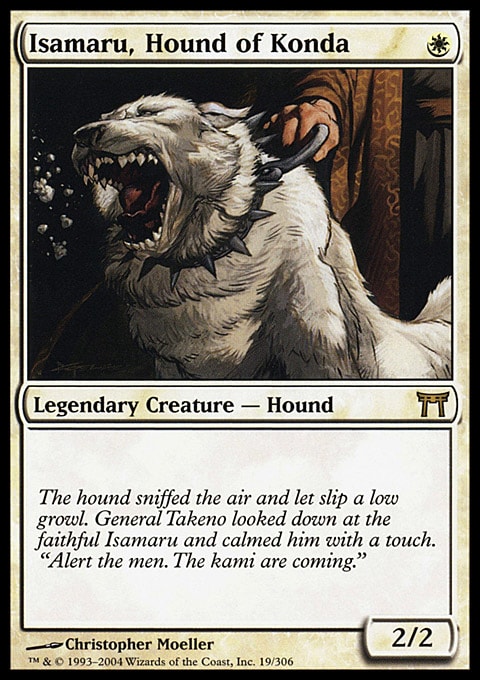We spend a lot of time discussing, debating, admiring, and loathing the best creatures in Magic. Thragtusk, Restoration Angel, Geist of Saint Traft, and Thundermaw Hellkite have dominated Standard headlines all year long. Many Modern discussions have centered on the banning of Bloodbraid Elf. Not every creature is a star, however. Only 21% of the Standard-legal creatures have been included in a Top 16 deck of a major tournament since rotation.
This article is about the other creatures, the ones that don’t sculpt decks and warp formats around themselves. The humble role-players, Limited curve-fillers, and booster pack castoffs. It’s about vanilla creatures such as Markov's Servant instead of the chocolate-fudge-brownie-extreme creatures such as Falkenrath Aristocrat. I will review three groups of creatures: vanilla, French vanilla, and virtual vanilla. For each, I’ll provide some examples, review their prevalence and competitiveness in Magic, and talk about what value they provide.
Vanilla
Vanilla creatures have no abilities and no rules text—just power, toughness, and converted mana cost. The recipes for many vanilla creatures were first put to cardboard at the beginning of Magic.

These older recipes are iconic. Creatures that cost 2 for a 2/2 are frequently referred to as “bears,” whereas a 2/2 for 3 is a Gray Ogre. Some of these recipes have changed over many years and multiple expansions, though others have stayed the same.

Magic’s earliest sets laid the groundwork of the game and included a large number of vanilla creatures. Core sets are a way to attract new players through less complex cards that make it easier to learn the game, and those sets also include a lot of vanilla flavoring. The following graph displays the Magic expansions with the highest percentage of vanilla creatures.

Recent noncore expansions contain far fewer vanilla creatures. Between three and four percent of the creatures in Innistrad, Dark Ascension, Avacyn Restored, and Return to Ravnica are vanilla. In total, thirty-six vanilla creatures are Standard-legal, and none of them have seen play in a Top 16 deck. They do see Constructed play from time to time, however.

You could do worse for a mana curve. If your vision of vanilla includes gold cards, you can add Woolly Thoctar as a beastly beater and perhaps even Grizzled Leotau for some solid defense to that list. There is even a vanilla legend:
Vanilla creatures are important to Magic for a few key reasons. First, they help new players learn to play the game. Learning about power and toughness and combat damage is much easier without creatures flying, first striking, and providing bonuses to each other. Second, they establish a baseline for creature capability and evaluation: a 2/2 for 2 mana is a “bear,” which makes Darkthicket Wolf a “bear with upside” and Flinthoof Boar good enough for Constructed. Third, they help flesh out decks in Draft and Sealed, where you need bodies on the battlefield to win.
French Vanilla
French vanilla creatures have a single keyword ability such as flying, haste, or lifelink.

Deciding which keywords constitute vanilla is inexact and subjective. I went with deathtouch, defender, double strike, first strike, flash, flying, haste, hexproof/shroud, regeneration, intimidate/fear, landwalk, lifelink, protection, reach, trample, and vigilance. You could make a case for exalted and others, but this list covers the major ones.
Check out the graph below showing the sets with largest number of French vanilla creatures.

Once again, early expansions and core sets have the most. Recent fall expansions—large sets that lead into a new block—still pack quite a few French vanilla options. Innistrad came in at 6%, and Return to Ravnica contained 8% French vanilla creatures. In terms of competitiveness, this slightly stronger version of vanilla is still a bit lacking. There are thirty-one Standard-legal French vanilla creatures, but only Fencing Ace and Rakdos Shred-Freak have been included in a Top 16 deck.
French vanilla creatures also help manage the complexity of the game, particularly at the common and uncommon rarities. It is not terribly difficult for new players to get the hang of these keywords, and they provide some extra creature capability. Like vanilla, French vanilla creatures are also important in Limited decks.
Virtual Vanilla
A virtual vanilla creature has an enters-the-battlefield ability that impacts the game the turn it is cast, but then, it becomes a vanilla creature. Each is effectively a vanilla creatures with a bonus spell stapled onto it.

With virtual vanilla creatures, we start to see the biggest percentages in the expert expansions.

Return to Ravnica is on this list, and Dark Ascension is not far behind at 7%. Virtual vanilla creatures frequently see Constructed play and serve important roles in competitive decks. There are fifty-three Standard-legal virtual vanilla creatures, and about 30% of them have been included in a Top 16 deck.

Virtual vanilla creatures are important because they can have a significant impact on the game without substantially increasing its complexity. Once an enters-the-battlefield ability resolves, the creature is vanilla and much easier to account for on the battlefield. Enters-the-battlefield abilities are also a way to emphasize creatures in Magic, ensuring that they provide some value even if they are destroyed immediately by a Doom Blade, Lightning Bolt, or similar effect.
Closing
Vanilla creatures play an important part in Magic: The Gathering. They ease new players into the game, keep unnecessary complexity under control, provide a method for evaluating creatures, and help balance the Limited format. I hope you enjoyed this look into these unsung creatures and found it informative. Thanks for reading!
Nick Vigabool























